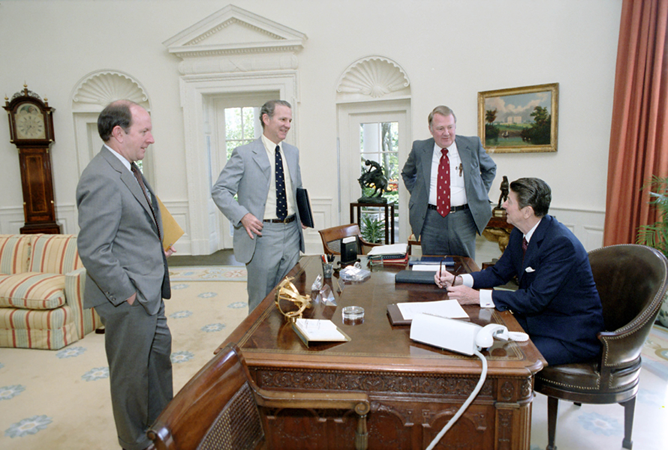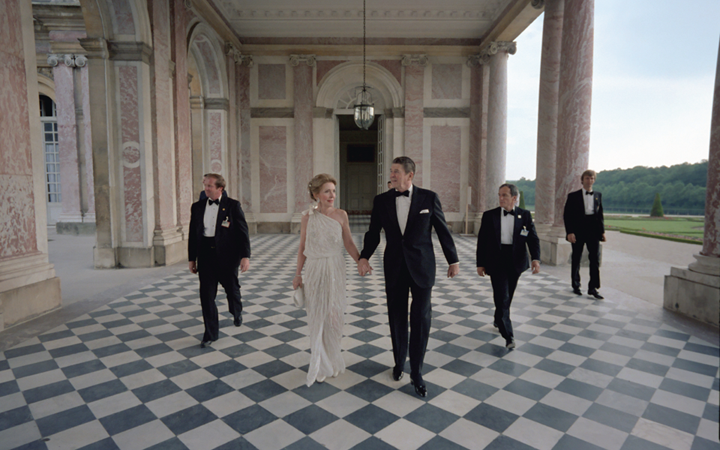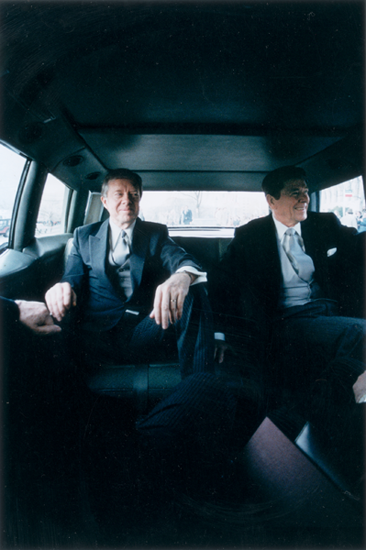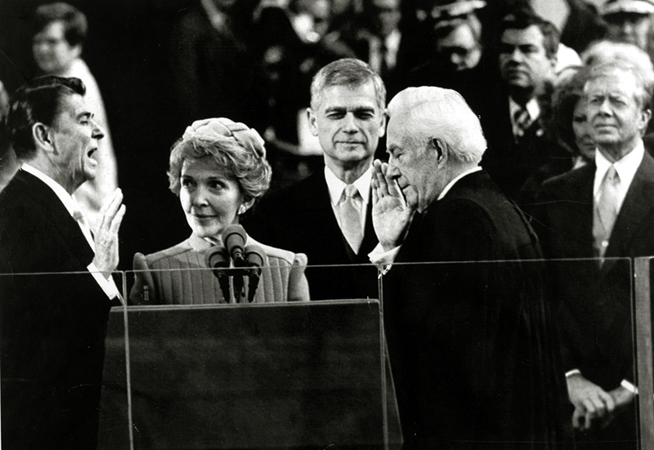
President Reagan broke tradition by holding his inaugural ceremony on the west side of the Capitol so he would face his beloved state of California, 1981.
The Ronald Reagan Presidential Library
Ronald Reagan made a point of saying that one does not “become” president. Rather, the president is “given temporary custody of this great institution which was created by our Founding Fathers.”
When “custodian” Ronald Reagan took the oath of office as America’s fortieth president on January 20, 1981, the country was experiencing one of its bleakest economic times since the Great Depression. Taxes, unemployment, and interest rates were high, and the national morale was low.
Restoring America’s economic health was the new president’s top priority. He shared his vision in his first inaugural address:
This administration’s objective will be a healthy, vigorous, growing economy that provides equal opportunities for all Americans, with no barriers born of bigotry or discrimination. Putting America back to work means putting all Americans back to work. Ending inflation means freeing all Americans from the terror of runaway living costs. All must share in the productive work of this “new beginning,” and all must share in the bounty of a revived economy.
President Reagan had earned a degree in economics at Eureka College, and even though he would sometimes joke about “two economists having three opinions,” he knew what needed to be done and how to do it. He had a simple but specific plan of which he had spoken often during the campaign: Cut taxes, get control of federal spending, and get the government out of the way so that the entrepreneurial spirit of the American people could be unleashed. Some skeptics derisively called his plan “Reaganomics,” but President Reagan was undeterred. He knew that if people had money in their pockets and incentives to invest and build businesses, jobs would be created, inflation tamed, and interest rates reduced.
As soon as the inaugural ceremony was over, President Reagan set his sights on Capitol Hill. From day one, he and his team worked tirelessly to get Congress to pass legislation to put the economy back on track.

President Reagan holding a senior staff meeting with Mike Deaver, James Baker, and Ed Meese on his first official day back in the Oval Office after recovering from the assassination attempt, 1981.
The Ronald Reagan Presidential Library
He nearly lost his chance when on March 30, 1981, he was shot and seriously wounded in an assassination attempt. As he was getting into his car after giving a speech at a Washington hotel, a bullet ricocheted off his limousine door and lodged perilously close to his heart. Secret Service agents practically threw him into the presidential limousine and took off for the White House. On the ride over, he had trouble breathing and was coughing up blood, so they diverted him to the George Washington University Hospital’s emergency room.
By the time the motorcade arrived at the hospital, President Reagan was weak and nearly collapsed as he tried to walk from his car to the emergency room door. He was immediately placed on a gurney, where doctors and nurses began to work on him. Drifting in and out of consciousness, he looked up and saw Nancy. In a barely audible voice he said, “Honey, I forgot to duck,” and was whisked into surgery while Nancy waited nearby. With her was Sarah Brady, wife of Press Secretary Jim Brady, who had taken a bullet in his head and whose survival was very much in doubt. Brady had also been taken to the George Washington University Hospital by ambulance shortly after the president.
The president survived the surgery, but developed an infection in the days following and came very close to dying. Brady, too, survived surgery but emerged with severe brain damage, leaving him unable to care for himself and with reduced cognitive skills. Despite the fact that Brady could not actually perform the duties of the president’s press secretary, Reagan decided Brady would keep that title for the remainder of his presidency.
Even an assassination attempt did not slow the new president down. While still recovering, he summoned congressional leaders to the White House to press his support for his economic recovery proposals. Ronald Reagan may have been the first president to wear pajamas to a meeting with the bipartisan congressional leadership. He wanted them to know he meant business.
His efforts paid off. In August, President Reagan signed the Economic Recovery Tax Act of 1981, which brought reductions in individual income tax rates, the expensing of depreciable property, and incentives for small businesses and for savings. So began the Reagan Recovery. A few years later, the Tax Reform Act of 1986 brought the lowest individual and corporate income tax rates of any major industrialized country in the world.
The numbers tell the story. Over the eight years of the Reagan administration:
• Twenty million new jobs were created;
• Inflation dropped from 13.5 percent in 1980 to 4.1 percent in 1988;
• Unemployment fell from 7.6 percent to 5.5 percent;
• The net worth of families earning between $20,000 and $50,000 annually grew by 27 percent;
• The real Gross National Product rose 26 percent;
• The prime interest rate was slashed by more than half, from 21.5 percent in January 1981 to 10 percent in August 1988.
Given actual rates of inflation, through 1987, the Reagan tax cuts saved the median-income, two-earner American family of four close to $9,000 in taxes from what it would have owed in 1980.
Tax cuts were only one “leg of the stool.” The second was job creation. Millions of new jobs were created, and as President Reagan had pledged in his inaugural address, they were not limited to just one segment of society. Employment of African Americans rose by more than 25 percent between 1982 and 1988, and more than half of the new jobs created were filled by women.
Taming the lion of government spending was another key component of the plan—the third leg of the stool. Here, too, President Reagan did what he said he would do. During his administration, growth in government spending plummeted from 10 percent in 1982 to just over 1 percent in 1987. With inflation factored in, federal spending actually declined in 1987—the first time that had happened in over a decade.
So impressive was the Reagan Recovery that at the 1983 G-7 Economic Summit, when it was obvious the president’s plan was working, the West German chancellor asked him to “tell us about the American miracle.” That was quite a turnaround from two years earlier, when President Reagan outlined his economic recovery plan to a group of skeptical world leaders. Now, however, they all wanted to know how he did it, so he told them: Reducing tax rates restored the incentive to produce and create jobs, and getting the government out of the way allowed people to become entrepreneurs. From there, the free marketplace operated as it should.
As President Reagan observed with a wry smile, “I could tell our economic program was working when they stopped calling it Reaganomics.” What pleased him most about the Reagan Recovery was not the vindication or all the impressive statistics. To him, the success of Reaganomics was what it brought to the American people. Millions had good jobs and were able to keep more of the money for which they worked so hard. Families could reliably plan a budget and pay their bills. The seemingly insatiable federal government was on a much-needed diet. Businesses and individual entrepreneurs were no longer hassled by the government, or paralyzed by burdensome and unnecessary regulations every time they wanted to expand.
Achieving the American dream was possible once again.

The Reagans attend a dinner at the Grand Trianon Palace in Versailles, France, during the annual economic summit, 1982.
The Ronald Reagan Presidential Library

Outgoing U.S. President Jimmy Carter sits with president-elect Ronald Reagan en route to Reagan’s presidential inauguration ceremony, 1981.
Getty Images

Ronald Reagan is sworn in as president by Chief Justice Warren Burger, 1981.
Getty Images